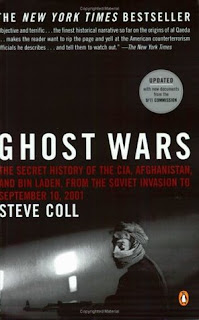I thought I had forgotten all about this book, but when the Taliban rapidly and rather effortlessly took over Afghanistan and the news reports as well as the discussions that ensued at the dinner among the flat-mates, I felt guiltily ignorant about the whole thing, a history, that was happening before my eyes.
As I often do in these situations, I went online to look for books that would give me a historical background to the Taliban takeover; the soviet invasion of the 80s, the Taliban takeover part-one in 90s, the 9/11 in 2001, America’s war on terror, and so on. Coll’s ‘Ghost Wars’ was at the top the recommendations. Seeing its cover, featuring a face-covered terrorist with a Kalashnikov in his hand standing in a dark room lit only by the light coming in from the windows, I remembered picking up this book few years back at the local book-stalls, but didn’t buy it because it didn’t seem urgent nor was it a welcoming read, being a thick nonfiction book over 500 pages.
I started reading this book when the Taliban-takeover topic was hot and running on every news; I have finished this book when it seems so distant in the past. It is incredible how the modern media is so focused on the latest news and discards every news, no matter how urgent or important they might be, once it is no longer ‘current’. In this connected world of ours, something or the other always happens, and the media likes to cover every bit of that.
In the prologue of this book, Coll writes how the Soviet called the Afghan fighters ‘dhuki’ or ghosts, for they were unable to grasp who they actually were. Reading the entirety of this era, starting from the Soviet invasion of 80s all the way to Sept, 2001, I can see why would they be called ghosts and this whole war a series of ‘ghost wars’. Even in their own land, the Afghans have always fought by the support of other countries, whether monetary, intellegencia, or military. The direct influence from foreign countries meant that the Afghans always fought on behalf of someone or someone’s interest, and never fully for their own goals – like for the Americans when Soviet invaded – which made them really unpredictable and elusive, just like ghosts.
And as we see throughout this book, there never was one military group fighting in Afghanistan; there were multiple groups, backed by different outsiders, fighting for different ends. The secular Ahmad Shah Masoud fought against the Soviets and later the Taliban; Hekmatyar Gulbuddin fought for being the dominant Pashtun ruling group in Afghanistan; Mullah Omar fought for an Islamist governance in Afghanistan. And so, all these groups and their interchanging motives and narratives depending upon who funds them when and for what interests, make for an ungraspable enemy for the west, an enemy who has shifts and changes, has no single or locatable motive, and is more than one. Even within themselves, they might appear like ghosts to each other; fighting for their country but with different means and ends.
Despite being a comprehensive and inside-ful book, or because of it, reading
this book required forced effort. From which I may conclude two things: while
reading on being triggered can opportune, getting into something with such a
superficial cause can be disappointing down the road; and while knowing things
from the surface seems easy, getting in the midst of it is a complex and
testing endeavor.
Ratings: 4/5 **** October 5, 2021_

